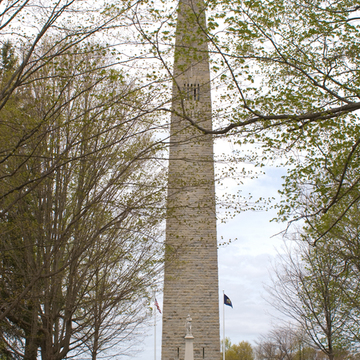The Bennington Battle Monument is perhaps the most astonishing landmark in Vermont in terms of scale and its bold domination of both distant rural views and the nearer visual axis of Monument Avenue. It commemorates the battle against the British on August 16, 1777. Although this battle actually occurred in New York State, some six miles to the west, it has been celebrated locally since 1778 as Bennington's crowning moment. As early as 1853, an association was chartered to finance and construct a memorial. Enthusiasm for the project was reinvigorated at the time of the nation's centennial and designs were proposed between 1877 and 1884. These designs evolved from a statue atop a 100-foot-high granite column similar to the Washington Monument in Baltimore, to a more elaborate 60-foot-high octagonal granite tower that carried a colossal statue atop a square base with corner figures, and, finally, to a simple, tapered 306-foot-high shaft designed by Boston architect Rinn in the mode of the Bunker Hill Monument in Boston and the Washington Monument on the National Mall.
In Bennington, the great obelisk was built in a five-acre elliptical park created at the head of what had been the village's main street on the site of the arsenal that British general John Burgoyne had intended to capture. Contractor William Ward of Lowell, Massachusetts, began construction in 1887, completing it three years later for a cost of one hundred and twelve thousand dollars. The blue, rock-faced Sandy Hill dolomite obelisk (with a two-ton capstone) has strongly textured surfaces; a gradual, almost entasis-like transition from shaft to point; and clustered tall, slitlike observation windows. These give the monument a robust physical expressiveness not shared by its more crisply faceted models. The monument's dedication in 1891 by President Benjamin Harrison, in conjunction with the centennial of Vermont's admission to the Union, brought a crowd of 30,000 to 40,000 observers to Bennington. The monument's physical conferral of Revolutionary landmark status on Old Bennington and the novelty of ascending to its observation level via elevator or the iron staircase (now closed) have continued to draw visitors ever since. The attention it brought was instrumental for the rehabilitation and conservation of Old Bennington. In 1952 ownership of the monument was transferred to Vermont as a State Historic Site. The state restored it in 2005 and continues to operate it today.





















